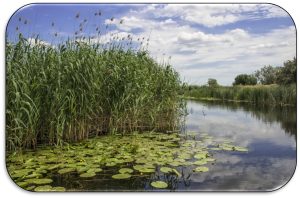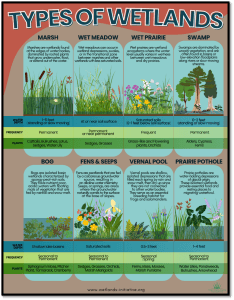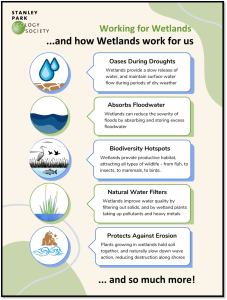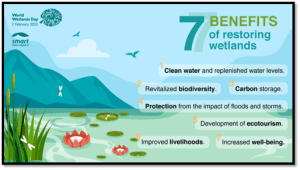Wetlands Matter:
Protect, Restore, Thrive
By Alyssa Jairam

Source: https://dac.nepa.gov.jm/
1.0 Introduction
Wetlands are areas where water covers the soil or is present either at or near the surface of the soil for varying periods of time. These include swamps, marshes, peatlands, rivers, lakes, deltas, estuaries and mangroves (Mitsch and Gosselink, 2015). These ecosystems are vital for the planet’s ecological health and are often referred to as ‘Nature’s kidneys’ since they are responsible for filtering and purifying water on earth (WWF, 2023).

Source: The Wetlands Initiative
2.0 Purpose of World Wetlands Day
This day is observed each year on 2nd February and marks the adoption of the Ramsar Convention on Wetlands in 1971 which is a pivotal treaty aimed at their conservation and sustainable use (Ramsar Convention Secretariat, 2023). These ecosystems are among the most productive and valuable ecosystems on Earth, serving as cradles of biodiversity and essential components of our planet’s natural balance.
The purpose of World Wetlands Day includes (UNEP, 2023):
- Raising awareness about the value of wetlands for humanity and the planet.
- Promoting conservation and restoration efforts globally.
- Encouraging governments, organizations, businesses and individuals to prioritize its protection in policies and practices.
3.0 Global Statistics about Wetlands
- They cover approximately 6% of the Earth’s surface (Ramsar Convention Secretariat, 2023).
- Since 1970, about 35% have been lost worldwide (IPBES, 2019).
- They are disappearing at a rate that is three times faster than forests (WWF, 2023).
- Nearly 40% of all species rely on freshwater ecosystems for survival (IUCN, 2023).
- They store around 30% of the world’s terrestrial carbon despite occupying a small fraction of its area (Moomaw, 2018).
4.0 Why Wetlands Matter (Key Benefits)
Wetlands provide countless ecosystem services such as: regulating water cycles, mitigating climate change and supporting diverse species. They are also essential for human well-being by offering livelihoods, cultural significance and recreational opportunities (Mitsch & Gosselink, 2015).
Some benefits of wetlands include:
- Biodiversity Hotspots: They support a vast array of flora and fauna species, some of which are found nowhere else (IUCN, 2023).
- Water Purification: They filter pollutants which improve the water quality for ecosystems and communities (WWF, 2023).
- Flood Control: They as natural buffers by absorbing excess water and reducing the risk of floods (Ramsar Convention Secretariat, 2023).
- Carbon Sequestration: Along with peatlands, they store large amounts of carbon which aid in mitigating climate change (Moomaw, 2018).
- Livelihoods and Resources: They provide fish, rice and other resources essential for human survival (UNEP, 2023).
- Climate Regulation: They help to moderate temperatures and contribute to local weather patterns (Mitsch and Gosselink, 2015).
- Tourism and Recreation: They are also popular tourist sites for activities such as birdwatching, boating and photography (WWF, 2023).

Source: Stanley Park Ecology
5.0 Restoration
Restoring wetlands is crucial for reversing their decline and ensuring their continued benefits.
This can be achieved by:
- Rewetting Degraded Wetlands: Reintroduce water to drained/dried wetlands for revival of their ecosystems (IUCN, 2023).
- Reducing Pollution: Limit agricultural runoff, industrial discharges and plastic waste to improve wetland health (UNEP, 2023).
- Using Land Sustainably: Integrate wetland conservation into urban planning, agriculture and infrastructure projects (WWF, 2023).
- Reforestation and Planting of Native Species: Restore mangroves, reeds and other native vegetation to enhance biodiversity and resilience (Moomaw, 2018).
- Encouraging Community Engagement: Educate and involve local communities in conservation projects (Ramsar Convention Secretariat, 2023).
- Implementation of Policies: Develop and strengthen policies that prioritize their protection and restoration (IPBES, 2019).
- Monitoring and Research: Invest in scientific studies to track wetland health and the effectiveness of restoration efforts (Mitsch & Gosselink, 2015).

Source: Smart Water Magazine
6.0 Conclusion
World Wetlands Day serves as a powerful reminder of the critical role they play in maintaining ecological balance and supporting life on Earth. Their preservation and restoration are not just environmental imperatives but also key to addressing global challenges like climate change, water scarcity and biodiversity loss. Let us use this day to renew our commitment to safeguarding wetlands and ensuring they thrive for generations to come.
“Wetlands are not wastelands; They are wonderlands.”
References
- 2019. “Global Assessment Report on Biodiversity and Ecosystem Services.”
- 2023. “International Union for Conservation of Nature Wetlands Overview.”
- Mitsch, W. J., and Gosselink, J. G. 2015. “Wetlands (5th ed.)”.
- Moomaw, W. R., Chmura, G. L., Davies, G. T., Finlayson, C. M., Middleton, B. A., Natali, S. M., Perry, J. E., Roulet, N., and Sutton-Grier, A. E. 2018. “Wetlands in a Changing Climate”.
- Ramsar Convention Secretariat. 2023. “About the Ramsar Convention”. Retrieved from Ramasar.org: https://www.ramsar.org
- 2023. “United Nations Environment Programme: Wetlands Protection.”
- 2023. “World Wildlife Fund: Wetlands Conservation.”
Want to learn more about how Kenson Group is promoting a greener environment? Discover some of the key activities through our Carbon Net Zero Capability Portfolio here: https://kenson.co.tt/kcnzcp/
